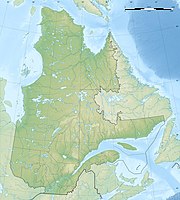Ecological Reserve of Mont-Saint-Pierre
|
Ecological Reserve of Mont-Saint-Pierre
|
||
| location | La Haute-Gaspésie , Québec, Canada | |
| surface | 6.43 km² | |
| WDPA ID | 308492 | |
| Geographical location | 49 ° 11 ' N , 65 ° 48' W | |
|
|
||
| Setup date | 2001 | |
| administration | MDDEP | |

The Réserve écologique de Mont-Saint-Pierre is a 643 hectare protected area established in 2001 in the south of the Canadian province of Québec , in the regional county municipality of La Haute-Gaspésie in the Gaspésie region . It is located near Mont-Saint-Pierre in the valley of the Rivière de Mont-Saint-Pierre .
The area protects the scree slopes on the steep slopes of the valley , formed on the rock foundations of the Ordovician and post-glacial deposits and based on greywacke and clay till. Weathering processes of the subsoil, dried out rivers, the movement of sandstone blocks, sliding movements on snow and ice and superficial or subsurface landslides are observed here.
The temperature at sea level averages 3 ° C, but reaches 20 in July and −13.8 ° C in January. About a third of the 1000 mm of precipitation per year falls as snow between mid-October and the end of April. During this time there is an additional 20 mm of rain per month. Usually as a north-westerly wind, but often also as an easterly wind sweeping across the country, speeds of more than 100 km / h are often reached. While there is occasionally 55 cm of snow in the valley, further above 3 m, sometimes even 4 m, is not uncommon. There is 1 to 1.5 m of snow that thaws by the end of May.
Above the slopes there is a plateau where yellow birch ( Betula alleghaniensis ) and paper birch ( Betula papyrifera ) predominate, as well as balsam fir ( Abies balsamea ) and western arborvitae ( Thuja occidentalis ). In the higher areas there are dense and squat islands of thuja, which, as they say in Québec, are known as "crooked wood". They make the power of the extremely strong winds tangible. There, however, the forest is on the decline. Snow and stone avalanches play a significant role in this. Since the 1950s there have been landslides 30 m wide and 200 m long that destroyed 6000 m² of forest.
The botanist Merritt Lyndon Fernald (1873–1950) from Harvard University established in 1923 and 1927 that a large number of rare plants grow in this area . However, it was not until 1974 that a protected area was proposed and it was another 27 years before the area was placed under strict protection.
The trigger was the fate of a single plant species. The park contains about three-fifths of Québec's populations of Astragalus scupulicola , which is now counted as Astragalus australis , while it was previously thought to be an endemic species. It is one of the 1600 to 2500 species of the genus tragacanth ( astragalus ), which in turn belongs to the subfamily of the butterflies within the legume family . It is extremely rare. It is found in only three locations in Quebec, one in Ontario and three in Manitoba . Otherwise it is only found in western North America. In Québec, one location is known on Ottawa , two on Lac Témiscamingue and five on Mont Saint-Pierre; in total there are only about 3000 copies. Of the 1500 to 2000 specimens on Mont Saint-Pierre, 90% are in the protected area. In the past, the plant was plucked frequently and therefore it is found in 50 herbaria in the province of Québec alone . It has been on the list of critically endangered species since 1992.
The rare plants also include Oxytropis viscida (English sticky locoweed), then Erigeron compositus from the genus of professional herbs or the silver olive ( Eleagnus commutata ), which is called chalef argenté here . Companion of Astragalus are often the ash or Labrador Rose ( Rosa blanda ), the Round-leaved bellflower ( Campanula rotundifolia ), trifoliolata Premanthes that the composite flowers counts Prunus pumila var. Depressa (Engl. Eastern sandcherry), a sand cherry , finally Dryas drummondii , a species of the genus Silberwurzen that occurs only in Northeast Asia and North America.
literature
- Francis Boudreau: La réserve écologique de Mont-Saint-Pierre, en Gaspésie , in: Le Naturaliste Canadien (2002) 78-82.
Web links
- Réserve écologique de Mont-Saint-Pierre , government website
Remarks
- ↑ Fernald, Merritt Lyndon, 1873-. Papers of Merritt Lyndon Fernald, 1893-1934: A Guide ( Memento of the original from July 16, 2010 in the Internet Archive ) Info: The archive link has been inserted automatically and has not yet been checked. Please check the original and archive link according to the instructions and then remove this notice. , Harvard University Library.


